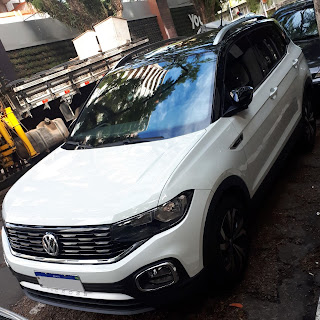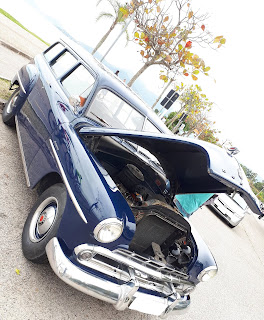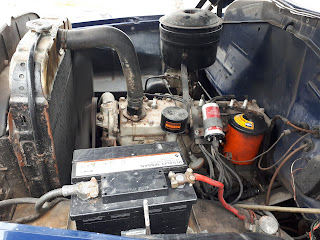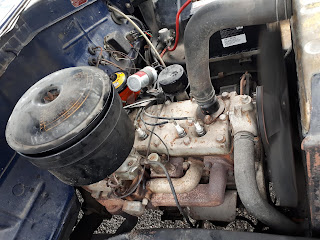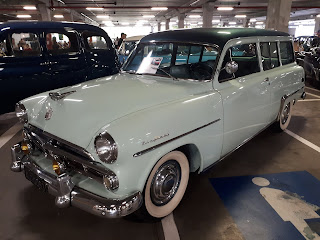This electric urban shuttle bus was made in Brazil, with a Mercedes-Benz O-500M chassis converted to electric by Eletra, a company specialized in electric drivetrains for heavy commercial vehicles that used to be mostly known for its serial hybrids but now supplies more full-electric systems catering to the trolleybuses of São Paulo city. This one specifically resorts to solar charging for its batteries bank, and is undergoing tests at the Santa Catarina State Federal University (UFSC - Universidade Federal de Santa Catarina) operating regular routes between its main campus and the Sapiens Parque, both in the Florianópolis island.
The body is a Marcopolo Torino Low-Entry, very similar to some Diesel-powered ones that operate regularly in my hometown Porto Alegre, while the overwhelming majority of the urban bus fleet in Florianópolis is front-engined with raised floor. Some differences between this one and a normal bus are mostly noticeable on the roof-mounted battery trays and solar panels, while the cockpit has a few different buttons, a rotary dial instead of the shift buttons for a normal automatic transmission, and the absence of a tachometer.
The electric motor is made by Weg, a company that is headquartered in Jaraguá do Sul, Santa Catarina state, but the electronic controls are developed in-house by Eletra, while the batteries are imported. The chemistry of batteries have been a complex matter, not just due to the improvements on the energy density required for mobile applications such as a vehicle but also because of factors such as the environmental impact of its end-of-life handling nowadays frequently referred to as "reverse logistics". Lithium batteries are not as easy to recycle as Lead-Acid ones which are still more common powering the accessories and the electronic controls in a more conventional vehicle with an internal-combustion engine.
One thing I can't deny, this bus got me thinking about some previous opportunities to develop local technologies for electric vehicles, including batteries with a higher efficiency back in the day when it was either Lead-Acid or those highly toxic Nickel-Cadmium ones. It's impossible to neglect the efforts of João Augusto Conrado do Amaral Gurgel, the same developer of a local attempt to replace the Beetle in the '80s, who also researched on batteries for EVs which he considered more promising than the ethanol despite his good relationship with the '64-'85 military government more supportive to ethanol. I'm sure it would be interesting to say the least if Gurgel's tetrapolar batteries get replicated with modern battery chemistry in order to improve its energy density...
Sunday, August 18, 2019
Thursday, August 15, 2019
Brazilian Volkswagen T-Cross: surprisingly the cheaper engine not available on the local market
Recently introduced in Brazil, the Volkswagen T-Cross had been available only with turbocharged engines also fitted with direct injection, either the 3-cylinder 1.0L or the 4-cylinder 1.4L of the TSI range. However, for some regional export markets such as Argentina and Uruguay, the 1.6L MSI still naturally aspirated and with port injection is the only one available. There were times when Brazilian versions of certain models had the simpler engines, while the ones available in neighboring countries were more sophisticated, so it's somewhat surprising to see it going the other way around. Possibly the fact that both Uruguay and Argentina don't have such a strict displacement-tiered vehicle taxation structure as the one enforced in Brazil, most of the Europe and China renders an older engine with a greater displacement more competitive than the 1.0TSI for the entry-level versions, even though at least the 1.4TSI could eventually make its way on to the export markets for the Highline trim. At least in Argentina, it's also worth to notice the popularity of CNG aftermarket conversions, for which the port-injected 1.6L MSI is easier to implement than the TSI range, even though both the 1.0L and 1.4L TSI engines are available in a TGI trim optimized for CNG while retaining the ability to use gasoline on limp-home mode.
Another aspect to consider is the eventual altitude compensation provided by a turbocharger, even though the turbo-lag becomes somewhat more noticeable further above the mean sea level. Uruguay is comprised mostly of flat lands, so this effect is mostly negligible, while Argentina also features some stretches of hilly terrain on its part of the Andean Mountains. Among other regional export markets, Paraguay and Mexico are also relevant to consider when it comes to the difference between some eventual suitability of different engine layouts on each market. Versions available officially in Paraguay are fitted with the very same TSI engines used in Brazil, including the ethanol-capable "flexfuel" trim, while in Mexico there is some rumor about which engines will be offered, and some sources mention the 1.6L MSI to be more likely to become available there and eventually supplemented with the 1.4L TSI to become available for the higher trims. But in the end, considering the differences between the tax structure in Brazil and export markets, the seemingly outdated yet cheaper 1.6L engine is still clearly favored over smallest TSI on regional export markets where the T-Cross is sourced from Brazil in order to benefit from the Mercosur and other trade agreements.
Another aspect to consider is the eventual altitude compensation provided by a turbocharger, even though the turbo-lag becomes somewhat more noticeable further above the mean sea level. Uruguay is comprised mostly of flat lands, so this effect is mostly negligible, while Argentina also features some stretches of hilly terrain on its part of the Andean Mountains. Among other regional export markets, Paraguay and Mexico are also relevant to consider when it comes to the difference between some eventual suitability of different engine layouts on each market. Versions available officially in Paraguay are fitted with the very same TSI engines used in Brazil, including the ethanol-capable "flexfuel" trim, while in Mexico there is some rumor about which engines will be offered, and some sources mention the 1.6L MSI to be more likely to become available there and eventually supplemented with the 1.4L TSI to become available for the higher trims. But in the end, considering the differences between the tax structure in Brazil and export markets, the seemingly outdated yet cheaper 1.6L engine is still clearly favored over smallest TSI on regional export markets where the T-Cross is sourced from Brazil in order to benefit from the Mercosur and other trade agreements.
Wednesday, August 14, 2019
4 reasons why sidevalve/"flathead" engines could make a comeback
1 - ease of servicing: with fewer parts, and some critical componets easier to reach whenever some technical intervention becomes required, it also saves time and thus enables the vehicle to resume its usual operating routine sooner. Even a full engine overhaul, if it ever becomes required during the useful operating life of a vehicle fitted with a sidevalve engine, takes less time and fewer raw materials are needed because of the lower amount of parts in need of a replacement;
2 - lower revving: leading to advantages such as a longer engine longevity, besides being optimized for low-end torque which enables keeping a comfortable cruising speed on a higher gear with fewer RPMs, the peak torque closer to idle may also render it easier for novice drivers to learn how to use a manual transmission (which nowadays with so many automatics might serve as somewhat of a passive anti-theft device). Obviously can't compare so accurately to a more rev-happy modern engine, but the greater lower-end torque renders a larger-displacement sidevalve operating at lower RPMs paired to a higher gear ratio suitable to perform the same tasks with fewer stress;
3 - low manufacturing cost: with fewer parts due to its simpler designs, and some such as the cylinder head being noticeably simpler than what would be found on any other 4-stroke engine, a sidevalve could appeal to some conservative and budget-conscious buyer. For work vehicles such as trucks, which are also usually not so burdened by a displacement-biased tax structure which is prevalent in Europe and South America, this advantage may remain easier to exploit;
4 - possibly beneficial side-effects of a lower compression ratio: in a time when most spark-ignited engines now feature direct injection in order to enable a sky-high compression ratio and lean-burn leading to a more Diesel-ish fuel efficiency, the more conservative compression ratio on a sidevalve may not be so bad at all. As it leads to a lower aerodynamic heating of the intake charge, a leaner air/fuel ratio won't increase any likelyhood to pre-ignition/knocks, all while it also avoids the increase on Nitrogen oxides (NOx) which now plagues most direct-injection gasoline-powered or "flexfuel" engines able to operate on ethanol. So, even with a more affordable and easier to service conventional port-injection system replacing the carburettors which prevailed on the sidevalves' days of glory, some competitive fuel efficiency may not be out of question. And if some alternate fuel such as CNG is used, which is not the case on the collector vehicles I usually see that still feature their original drivetrain such as this '53 Dodge Kingsway, it's roughly impossible to trim the mixture so low to still enable combustion amidst an increased risk of overheating usually associated to an excessively lean air/fuel ratio;
Subscribe to:
Posts (Atom)





